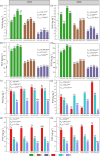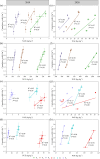Nitrogen and phosphorus fertilizer use efficiency improves alfalfa (Medicago sativa L.) production and performance in alkaline desert soil
- PMID: 40041012
- PMCID: PMC11876427
- DOI: 10.3389/fpls.2025.1526648
Nitrogen and phosphorus fertilizer use efficiency improves alfalfa (Medicago sativa L.) production and performance in alkaline desert soil
Abstract
The deficiency of nitrogen and phosphorus is a primary constraint on the normal growth of alfalfa (Medicago Sativa L.) in the alkaline desert soils of northern Xinjiang. Optimizing the combination of nitrogen and phosphorus fertilizers can maximally significantly enhance farmers' economic returns while concurrently mitigate soil environmental pollution. For this purpose, a field experiment based on a randomized complete block design was conducted over two consecutive years (2019 and 2020) in Shihezi, Xinjiang province, China. The WL366HQ variety of alfalfa was evaluated with four levels each of urea and monoammonium phosphate. The effects of fertilizer treatments were assessed on alfalfa yield, growth traits, nutritional quality, fertilizer use efficiency, and economic benefit. Application of nitrogen (N), phosphorus (P), and their interaction significantly (P< 0.05) affected cumulative alfalfa dry matter (DM) yield. In general, compared to no-fertilization treatment, the application of N and P fertilizers resulted in increased plant height, stem thickness, crude protein, and ether extract of alfalfa, while neutral detergent fiber (NDF) and acid detergent fiber (ADF) exhibited a decreasing trend. Additionally, while N and P fertilizer application reduced corresponding fertilizer use efficiency, it increased non-corresponding fertilizer use efficiency. During the two-year experimental period, the treatment involving the application of urea at 286.3 kg·ha-1 combined with monoammonium phosphate at 192 kg·ha-1 achieved the highest evaluation scores for production performance, fertilizer use efficiency, and total net profit, resulting in a net profit increase of 44.18% compared to the no-fertilizer treatment. These findings lay the groundwork for nuanced fertilization strategies in future alfalfa cultivation.
Keywords: agronomic efficiency; best management practices (BMPs); environmental concerns; rational and economical fertilization; yield enhancement.
Copyright © 2025 Sun, Sun, Wang, Cartmill, López, Ma and Zhang.
Conflict of interest statement
The authors declare that the research was conducted in the absence of any commercial or financial relationships that could be construed as a potential conflict of interest.
Figures












References
-
- AOAC (2005). “Official methods of analysis of the association of official analytical international,” in Method 989.05, 18th ed. Ed. Horwitz W. (AOAC International, Arlington, USA: ).
-
- Bastos L. M., Carciochi W., Lollato R. P., Jaenisch B. R., Rezende C. R., Schwalbert R., et al. . (2020). Winter wheat yield response to plant density as a function of yield environment and tillering potential: A review and field studies. Front. Plant Sci. 11. doi: 10.3389/fpls.2020.00054 - DOI - PMC - PubMed
-
- Bhandari K. B., West C. P., Acosta-Martinez V. (2020). Assessing the role of interseeding alfalfa into grass on improving pasture soil health in semi-arid Texas High Plains. Appl. Soil Ecol. 147, 103399. doi: 10.1016/j.apsoil.2019.103399 - DOI
LinkOut - more resources
Full Text Sources
Research Materials

